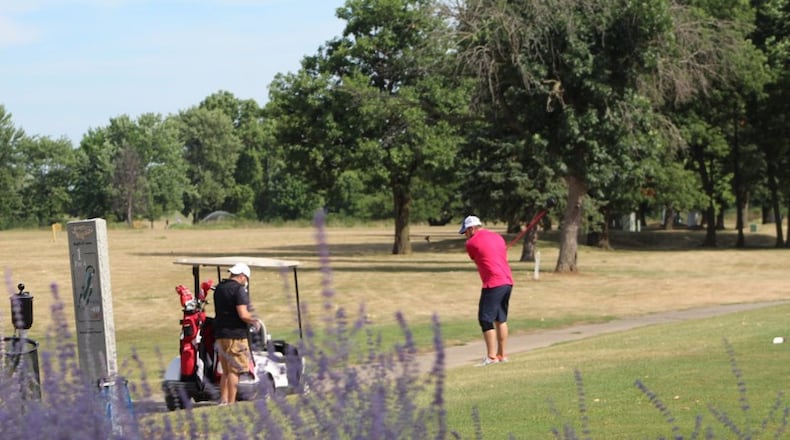Dayton is projecting an 18% shortfall in the general fund this year primarily because of lost income taxes due to the COVID-19 emergency.
But the city’s golf courses were in financial trouble before the public health crisis and the city already was evaluating whether to close some facilities.
“Simply put, having the general fund support golf operations is an impossible scenario considering the significant loss of revenue and budget cuts underway,” said Dayton City Manager Shelley Dickstein.
MORE: After 100 years, will Dayton get out of the golf business?
Dayton has been in the golf business for more than a century, but in recent years, its golf division has bled money and has required subsidies because of reduced interest in the sport and other factors.
Late last year, the National Golf Foundation completed a report examining the city's golf operations that recommended the city invest between $7.9 million and $9.9 million in its three facilities.
The city operates half a dozen 18-hole golf courses at Kittyhawk Golf Center, Madden Golf Course and Community Golf Club, which is south of the city in Kettering.
The foundation’s study determined the city’s golf courses would require a minimum subsidy of $7.5 million over the next five years, which would be a severe economic burden, said Dayton Mayor Nan Whaley.
About 20,000 people use the city’s golf courses each year, but only about 2,500 are Dayton residents, or less than 2% of the city’s population, Whaley said.
The city cannot continue subsidizing Madden and Kittyhawk, because it diverts money away from other important city services, especially at this critical juncture when the city is looking at 18% budget cuts across the board because of large revenue losses, Whaley said.
“For some, this might feel like a loss, but we are committed to making sure the city’s resources are being used in ways that benefit our residents most, particularly our young people and our seniors,” Whaley said.
Community Golf Course, the only city-owned golf course that makes money, accounts for nearly half of the golf system’s revenue and is located in a favorable, “golfer-rich” area, according to the foundation’s report and city officials.
Kittyhawk and Madden have significant deficiencies, including outdated irrigation systems and clubhouse and support buildings, the report said.
All three centers have significant issues with maintenance facilities and playing areas, as well as deteriorating bunkers, trees and water features.
Community first opened in 1918, while Madden opened in 1929 and Kittyhawk in 1961.
MORE: Dayton golf: Good numbers in 2019, but city leaders worried
Dayton’s golf division is an enterprise fund that is supposed to be self-supporting and break even, meaning it does not require general fund money, said City Manager Dickstein.
But the division has needed general dollars money for years, including $50,000 in 2019, even though it was considered a good year for revenue and rounds played.
Breaking even became increasingly difficult in the golf division because of aging courses, deferred maintenance and rising operating expenses amid declining demand in the sport, Dickstein said.
Reopening the six courses in compliance with social distancing and other COVID-19 protocols would require the city’s general fund to subsidize the operations to the tune of more than $500,000 for the remainder of 2020, Dickstein said.
During the COVID-19 crisis, the city decided to keep its golf centers closed even though the state allowed golf courses to operate as an outdoor recreation activity.
The city said its golf centers lacked the resources to actively monitor and manage social distancing to ensure safe operations to combat the spread of infection.
Community, however, is expected to reopen soon once a plan is in place to operate it safely, and moving forward, the golf center is expected to produce surplus revenue that can be used to support recreational services, Dickstein said.
The golf division has 13 city employees but its payroll will need to be reduced to about five as the system shrinks to just one golf center, city officials said.
The city was going to have to figure out what to do about its golf centers anyway, but the pandemic accelerated the timeline for making a decision, city leaders said.
The future of Kittyhawk and Madden is unclear, but the city will evaluate potential reuse, though there are challenges.
Kittyhawk sits on a wellfield, meaning residential and commercial redevelopment is out of the question.
Madden’s proximity to a wastewater treatment plant occasionally results in odors that might hurt its appeal and reuse prospects.
The millions of dollars in needed investment and upgrades make it unlikely that a buyer would emerge who would want to continue using the properties for golf purposes, Dickstein said.
The city wouldn’t lease or sell the properties to a golf operator without a firm commitment to make upgrades, she said.
The closures aren’t surprising, but they are sad because they will affect the community and impact the sport from an access standpoint since there will be fewer tee times available for golfers in the community, said Steve Jurick, executive director of Miami Valley Golf.
“It’s like losing a close friend who moved out of town and you will likely never be contact with again,” he said. “There is just a loss there and emptiness.”
Madden and Kittyhawk were liked and valued and provided a good entry point into the sport, and newcomers will have less inventory to begin their golf journey, Jurick said.
Many people believed Madden had the best routing, and all three courses at Kittyhawk had appeal, with the Eagle course being one of the longest and most difficult, he said.
About the Author

